 |
| The Mozah, the first Q-Max vessel, was delivered in 2008. (Photo courtesy of Samsung Heavy Industries Ltd.) |
Necessity, they say, is the mother of invention. To be more precise, in the case of ExxonMobil and partner Qatar Petroleum, necessity is the mother of major improvements to existing technology.
The two companies have been involved in a joint venture to develop Qatar’s North field, the world’s largest non-associated gas field with recoverable gas reserves of more than 900 Tcf. The gas is converted to LNG and shipped to ports around the world.
As the project grew to more and more gargantuan proportions, the partners began to evaluate the current state of LNG tankers and wonder if improvements could be made. Thus began a multiyear, multicompany project that has produced major breakthroughs in the way LNG is transported long distances.
Getting underway
As ExxonMobil and Qatar Petroleum’s plans for a major expansion of LNG production firmed up, the approach was to focus on the entire value chain, from field production to liquefaction, shipping, and receiving terminals. It was determined that a team comprising experts from both companies, aided by third-party experts, could begin to evaluate the current state of shipping and seek areas of improvement. “It’s a project with unique attributes,” said Tony Urbanelli, manager, LNG Transportation for ExxonMobil Development Co. “Within the value chain we looked at a significant increase in the volume and range of places to send the LNG.”
Conventional LNG tankers, in use since the 1960s, had already seen modest improvements, mostly in the amount of cargo they could carry. Some of the earliest vessel designs held 20,000 to 30,000 cu m. An expanding market eventually increased this capacity to 125,000 to 140,000 cu m by the 1970s. “The world was comfortable with that range for about 30 years,” Urbanelli said. “It made sense for the projects up to that point in time.”
Given the size of the Qatar project, however, the partners quickly saw the opportunity to extract some of the value in LNG shipping. A team began to examine several options — the size of the cargo capacity, the propulsion system, and the port flexibility, to name a few. Of paramount importance was the size of the vessel. “When you think of economies of scale, you think of size,” Urbanelli said. This led the team to examine the possibility of making the ships larger and increasing cargo capacity.
The first design change was the Q-Flex, capable of carrying 215,000 cu m of LNG. Already 20 of these ships have been delivered in the last year. The next step, the Q-Max, can carry 265,000 cu m. The first of these ships, the Mozah, was delivered in the fall of 2008.
Propulsion
Another area of attention revolved around the propulsion system of the vessel. Conventional LNG tankers use steam turbines, which are partly powered by the LNG that boils off during transit. This means that some of the precious cargo is actually used during the trip rather than being sold at market.
This wasn’t good enough for the ExxonMobil/Qatar Petroleum team. Why not find a propulsion system that didn’t rely on natural gas?
The team settled on slow-speed diesel engines, massive engines producing 25,000 hp or more while turning at around 100 rpm. The Qatar vessels rely on two propellers directly connected to the engines rather than the standard single-propeller design. Urbanelli said the water flow is more efficient with the dual-propeller system, plus it adds redundancy to the overall design.
Furthermore, diesel propulsion systems are “the mainstay of the merchant shipping industry,” Urbanelli said, so there is a broader base of mariners experienced with the systems.
But what about the boil-off? Since LNG is not refrigerated during transit, this is an unavoidable side-effect. But here again the team found a solution.
LNG that has been boiled off can be reliquefied. But this type of system had not been widely used on vessels before. “We looked at marinizing that technology to make it suitable for shipboard to account for motion, operational profile, and maintenance,” Urbanelli said. “It was a key enabler to improving efficiency.”
Additional tests surrounded the behavior of the LNG while in transit. Since the cargo capacity, and therefore the LNG tanks themselves (there are five per vessel), are larger than conventional tanks, they needed to be extensively tested to study their sloshing potential.
“The cargo containment systems used in membrane-type LNG ships are relatively complex structures,” Urbanelli said. The tanks comprise a metallic membrane that comes in contact with the LNG and can withstand the pressure and cryogenic temperatures, surrounded by insulation, then another membrane, then more insulation before coming in contact with the inner hull of the vessel (all of these vessels are double-hulled). “There are multiple layers of containment,” he said.
“We used a special test tank for sloshing analysis that allowed us to simulate ship motion. It gave us an understanding of how it would move, and we were able to test on the model scale tank in the conditions the ship would experience.” For design purposes, winter North Atlantic wave conditions were simulated.
After running thousands of tests, the tank designs were modified to increase their strength to withstand the sloshing loads. Urbanelli added that the classification agencies Det Norske Veritas, Lloyds, the American Bureau of Shipping, and Bureau Veritas were engaged in the analysis.
Commercial realities
New technology is great, but only if you can find a manufacturer. With shipyards around the world at full capacity, how were the partners going to secure the many ships needed to support the expansion in Qatar? Again, economies of scale played a key role.
ExxonMobil and Qatar Petroleum do not own any patents on these vessel designs. The company responsible for the cargo tank designs — Gaz Transport Technigaz (GTT) — and the three Korean shipyards responsible for the production — Daewoo, Samsung, and Hyundai — own the designs and are free to use them in any other projects they choose.
“What’s advantageous to us is that the shipyards look at this as technology they can use down the road,” Urbanelli said. “They can use the same ship design for multiple parties.”
The partners also do not own nor operate the vessels, but looked for third-party owners and operators, companies that are carefully vetted to ensure that safety standards are rigorously upheld.
“We looked for veteran ship owners and operators,” Urbanelli said. “We looked at their recruitment, staffing, and retention records, and we selected owners that met our safety standards and had the scale to maintain their staffing.” He added that LNG shipping is considered one of the more attractive shipping opportunities because of the sophistication of the ships and can therefore attract qualified personnel. Also, diesel systems are more familiar to ship operators.
Altogether, potential savings from this investment in LNG tanker improvement promises to be enormous. Oper-ational costs for the Q-Flex and Q-Max ships are similar to those for a conventional vessel. There is a 40% savings in the amount of energy used per unit of cargo, a 20% reduction in transportation cost, and an 80% improvement in the amount of cargo that can be delivered on a single vessel. Additionally, the 3-5% of LNG lost during the boil-off process on conventional vessels is virtually eliminated — Urbanelli said that one vessel held its cargo for five months and delivered 99.99% of it.
For those involved in the project, he said, it felt like a “once-in-a-career opportunity.”
“The amount of support from ExxonMobil and Qatar Petroleum has been just extraordinary,” he said. “The focus on technology and the LNG value chain really came across.”
Recommended Reading
Diamondback’s Van’t Hof Plays Coy on Potential Delaware Divestiture
2024-05-16 - Diamondback Energy’s President and CFO Kaes Van't Hof also addressed new Permian exploration and the lack of “fun” dealing with the FTC on its deal to buy Endeavor Energy Resources.
Minerals Market Growing But Needs More Scale, Consolidation
2024-05-15 - The market value of public minerals and royalties companies has doubled since 2019—but the sector needs to grow even larger to attract generalist investors into the fray, experts say.
Marketed: Berlin Resources Anadarko Basin Opportunity
2024-05-13 - Berlin Resources LLC has retained EnergyNet for the sale of an Anadarko Basin opportunity in the Donita 35/2 AP #1H in Roger Mills County, Oklahoma.
TotalEnergies, Sinopec to Develop SAF Unit in China
2024-03-26 - TotalEnergies and Sinopec’s production unit will have the capacity to produce 230,000 tons of sustainable aviation fuel per year.
‘Unexpected’ JV to Move Permian NatGas to Gulf Coast LNG Terminals
2024-03-26 - A trio of midstream companies—Enbridge, Whitewater and MPLX—will work together to build infrastructure to transport Permian Basin natural gas to Gulf Coast LNG terminals.




